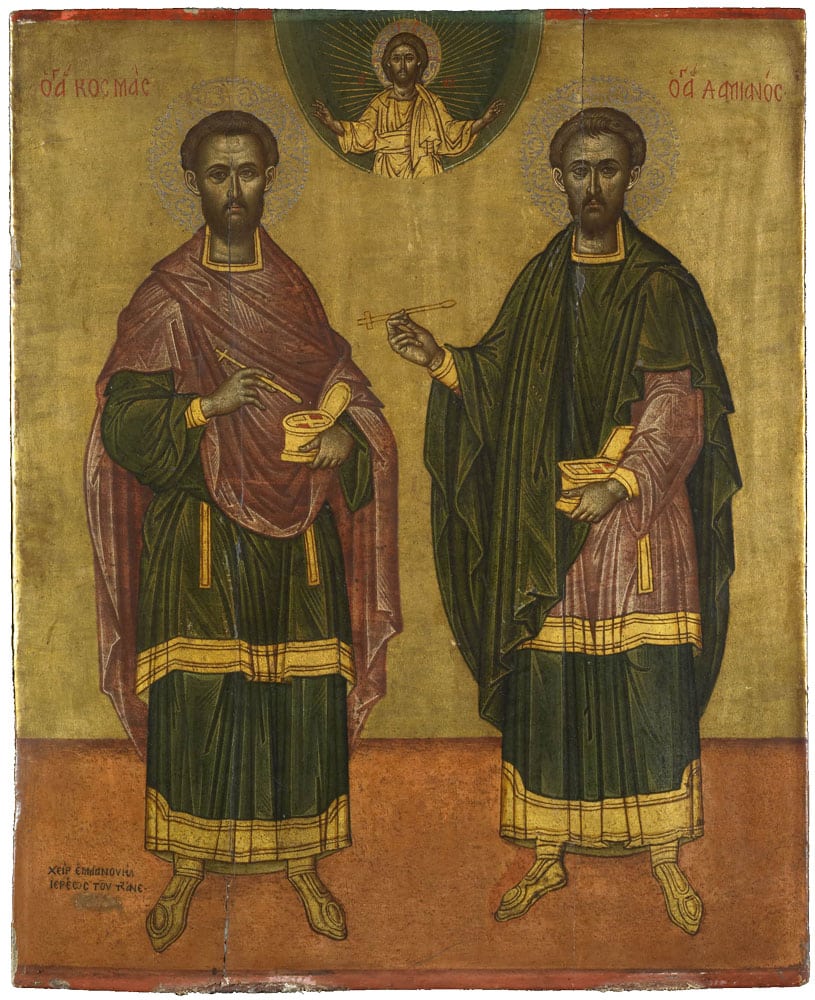The icon is painted in egg tempera with gold leaf on wood primed with gesso. Set against a gold background, the medical saints Kosmas and Damian are depicted full length with Christ blessing them at the top centre of the icon. Each saint wears a mantle and ankle-length tunic and holds a box of medicinal powders and a small ladle with cruciform handle. The figures are identified by inscriptions in majuscule Greek carefully written with the help of incised guidelines: Ο ΑΓ(ΙΟC) ΚΟCΜΑC (St Kosmas) on the left and Ο ΑΓ(ΙΟC) ΔΑΜΙΑΝΟC (St Damian) on the right. Their haloes are decorated in the punch technique with stylised scroll-like floral motifs. An incised preliminary design was employed in the execution of the figures although not always followed with precision, particularly in the rendering of St Damian’s right foot, which deviates by about 1cm from the initial sketch. Two narrow bands of red colour frame the icon at the top and bottom. At bottom left is a Greek inscription in red: XEIP EMMANOVHΛ IEPEωC TOV TZANE (‘Hand of Emmanuel Tzanes, priest’). The large panel is made of three pieces of wood strengthened on the reverse by two wooden battens and was probably used in the sanctuary screen of a church.
Kosmas and Damian, known as the Anargyroi (because they treated patients without asking for payment), are represented from the Early Christian period onwards in both Byzantium and the West.
The composition of this icon is symmetrical. The palette is limited to green, dusty rose, gold and orange. The two saints stand slightly turned towards the centre of the icon, holding boxes with medicines and cross-tipped spoons for dispensing them. They are dressed in Byzantine secular garments of similar alternating colours: a long tunic with tight sleeves under a shorter dalmatica (wide-sleeved tunic), both edged in gold and wrapped with a himation (cloak). A wide band of burnt orange colour represents the ground on which the saints are standing. In the middle of the upper part of the icon, within a bluish-green semicircle conventionally denoting heaven is a radiant half-length image of Christ in gold vestments blessing them.
The iconography of the icon follows a long-established Byzantine tradition. A frontal depiction of Sts Kosmas and Damian with a half-length image of Christ at the top, though crowning rather than blessing them, is found in the 12th-century frescoes of the Church of Hagioi Anargyroi in Kastoria (Pelekanidis and Chatzidakis 1985). This was the standard iconography of the saints, often without the image of Christ, even after 1453. For instance, the 16th-century double-sided icon with pairs of saints from the Rena Andreadis collection, Athens (Drandaki 2002) and a number of icons from the Georgios Tsakyroglou collection, Athens, dated to the 17th and 18th centuries (Karakatsanis 1980, 73, 95, no. 89; 118, 145, no. 148; 176–7, 190, no. 227; 181, 228, no. 357) repeat this type of representation. Variations in the iconography of Sts Kosmas and Damian include a standing image of St Panteleimon, another doctor saint, between them (Karakatsanis 1980, 36, no. 26, 177, no. 228).
At the bottom left corner of the icon is an inscription with the signature of the Cretan painter Emmanuel Tzanes (1610-1690): ΧΕΙΡ ΕΜΜΑΝΟΥΗΛ ΙΕΡΕωC ΤΟΥ ΤΖΑΝΕ (‘The hand of the priest Emmanuel Tzanes’), which has long been considered forged (Chatzidakis and Drakopoulou 1997; Cormack 2007, 104). Despite this, there is close correspondence between the BM icon and the works of Emmanuel Tzanes such as the 1649 icon of St Jason from the Church of St Jason and St Sosipatros in Corfu (Vokotopoulos 1990). In particular the meticulous and somewhat arid rendering of the flesh with olive brown for the shadowed parts and warm ochre for the skin, highlighted by a dense network of alternating thick and finer brushstrokes, is characteristic of Tzanes’ painting. This is also the case with the drapery folds, which are formed by different shades of the same colour, arranged in a geometrical manner that makes them appear rather flat and heavy. Additionally, the decoration of the saints’ haloes on the BM icon is very similar to that on works of Tzanes, for example, the icons of the Virgin and St John the Baptist from the three-piece Deisis housed at the Metropolitan Museum of Art, New York.
These considerations point to the conclusion that the icon should after all be linked to the work of Emmanuel Tzanes or his workshop. There seems now no good reason to doubt the authenticity of the signature.
Literature: J. Chittenden and C. Seltman, Greek Art. A Commemorative Catalogue of an Exhibition Held in 1946 at the Royal Academy Burlington House London, London, 1947, 52, no. 366, pl. 98R; H. P. Gerhard, Welt der Ikonen, Recklinghausen, 1957 and 1970, 97, pl. 22; The National Gallery Illustrated General Catalogue, London, 1973, 744, no. 594; A. Karakatsanis, Εικόνες συλλογής Γεωργίου Τσακύρογλου, Athens, 1980; S. Pelekanidis and M. Chatzidakis, Kastoria, Athens, 1985, 32, pl. 10; P. L. Vokotopoulos, Εικόνες της Κέρκυρας, Athens, 1990, 111, no. 74, pl. 52; M. Chatzidakis and E. Drakopoulou, Έλληνες ζωγράφοι μετά την Άλωση (1450-1830), Athens, 1997, 418; A. Drandaki, Greek Icons. 14th–18th century. The Rena Andreadis Collection, Athens, 2002, 76–9, no. 14; R. Cormack, Icons, London, 2007 (repr. 2014), 96, fig. 60, 104, no. 27, 119.
Eleni Dimitriadou
